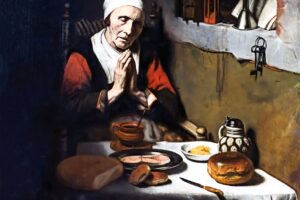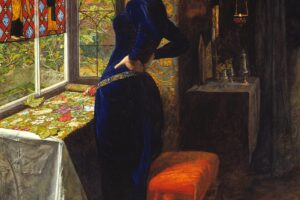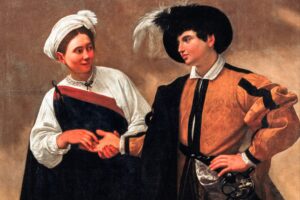Overview
A Sick Child Brought Into the Temple of Aesculapius (1877) by John William Waterhouse presents a poignant classical scene. At the center, a priest in white robes tends to a sacred fire while a mother carries her ailing child toward the altar. Attendants kneel or stand in reverence, their gestures reflecting both hope and anxiety. The temple interior, draped in garlands and bathed in warm light, conveys solemn ritual.
Waterhouse (1849–1917), best known for mythological and literary heroines, was still early in his career when he painted this historical subject. Influenced by the Pre-Raphaelites and classical antiquity, he combined naturalistic detail with dramatic narrative. The work foreshadows his later fascination with symbolic storytelling and richly staged compositions.
Exhibited in 1877, the painting was admired for its archaeological authenticity and emotional force. Today, it stands as a significant milestone in Waterhouse’s development, balancing realism, allegory, and human tenderness.
The Story Behind the Painting
Aesculapius in Ancient Myth
The subject draws from the cult of Aesculapius, the Greco-Roman god of medicine and healing. Sick individuals were often brought into his temples, where priests performed rituals of purification and supplication. Healing was sought not only through remedies but also through divine intercession, reflecting the union of religion and medicine in antiquity.
Waterhouse’s Early Career Choice
Painted in 1877, this canvas demonstrates Waterhouse’s interest in classical themes before his full embrace of mythic and literary narratives. His choice of subject reflects Victorian fascination with antiquity and the human dimensions of ritual. By portraying a sick child within a sacred context, Waterhouse created a scene both historically authentic and emotionally resonant.
Composition and Subjects
The Mother and Child
At the left, a young mother dressed in pale garments carries her sick child, whose frailty contrasts with the strength of her gesture. The child’s small hand stretches toward the priest, embodying both vulnerability and faith in divine aid.
The Priest at the Altar
In the center, a priest robed in white performs a ritual at a brazier. His pose conveys authority and devotion, while the rising smoke symbolizes prayer ascending to the gods. His calm presence anchors the drama of the scene.
Attendants and Setting
A girl kneels in supplication before the altar, her green robe flowing onto the marble floor. Behind them stand figures in darker garments, their solemnity emphasizing the gravity of the moment. Around the temple, garlands, fruit baskets, and sacred vessels enrich the atmosphere of ceremony.
The Temple Interior
Waterhouse paints the architectural setting with archaeological precision — marble columns, mosaics, and statuary inspired by classical models. The combination of sacred grandeur and intimate drama heightens the emotional impact.
Art Style and Techniques
Pre-Raphaelite Influence
The jewel-like palette, precise detailing of fabrics, and emphasis on symbolism reflect the influence of the Pre-Raphaelite Brotherhood. Waterhouse adopts their devotion to naturalism while moving toward a more classical clarity.
Academic Realism
As an early work, the painting also demonstrates Waterhouse’s academic training. Figures are carefully modeled, perspectives rendered accurately, and historical detail meticulously observed.
Foreshadowing Later Themes
Though classical in subject, the painting anticipates Waterhouse’s later works — women in moments of vulnerability, ritual, or transformation. The focus on atmosphere, gesture, and mood would become hallmarks of his mature style.
Legacy and Reflection
Reception in 1877
When exhibited, the painting attracted praise for its archaeological authenticity and dramatic sincerity. It helped establish Waterhouse as a rising talent, capable of merging classical history with emotional storytelling.
Enduring Meaning
Today, the canvas resonates as both history and allegory. It is a meditation on human vulnerability, the search for healing, and the timeless interplay of faith and medicine. Through its balance of ritual grandeur and maternal tenderness, Waterhouse elevates an ancient story into a universal truth.
A mother carries her frail child into the temple, a priest raises his hand in ritual, and smoke curls upward in prayer. In A Sick Child Brought Into the Temple of Aesculapius, Waterhouse transforms classical ceremony into timeless human drama — a moment of faith, fragility, and hope.
About Artist

John William Waterhouse RA (baptized April 6, 1849 – February 10, 1917) was a renowned English painter closely associated with the Pre-Raphaelite style and Victorian Romanticism. Born in Rome to English painter parents, Waterhouse moved to London in childhood, where he was exposed to a rich artistic environment near the Victoria and Albert Museum. He trained at the Royal Academy of Art, initially studying sculpture before switching to painting. Waterhouse became famous for his vibrant, detailed depictions of mythological, literary, and classical subjects, bringing the Pre-Raphaelite aesthetic into the early 20th century.
Artist Style and Movement
Waterhouse’s style bridges Academic art and Pre-Raphaelite influences, characterized by luminous colors, precise detail, and narrative richness. His subjects often derived from classical literature, myths, and poetry—especially works by Tennyson, Shakespeare, and Homer—delivered with romanticism and emotional intensity. He focused on female protagonists, enchantresses, and tragic heroines, exploring themes of love, fate, and destiny. Though rooted in Victorian ideals, his brushwork sometimes reflected Impressionist influences.
Artwork Profile
- After the Dance (1876): An early success capturing a courtly scene post-dance with refined detail and vibrant colors.
- A Sick Child Brought Into the Temple of Aesculapius (1877): A dramatic and poignant painting reflecting ancient themes of healing and faith.
- Diogenes (1882): A philosophical portrait of the Cynic philosopher Diogenes, embodying simplicity and defiance.
- The Favourites of the Emperor Honorius (1883): A richly detailed historical scene depicting imperial court life.
- Consulting the Oracle (1884): An evocative scene emphasizing Greek antiquity and mysticism.
- The North-West Passage (1874): A patriotic narrative painting recalling British exploration.
- Penelope and the Suitors (1912): Reflects Waterhouse’s fascination with Homeric epics, childbirth, and female virtues.
- “Am Half-Sick of Shadows,” Said the Lady of Shalott (1915): A late portrayal of Tennyson’s tragic heroine, encapsulating Waterhouse’s romantic and symbolic style.
John William Waterhouse’s enduring legacy lies in his masterful synthesis of Pre-Raphaelite romanticism and Victorian poetic storytelling. His paintings display an exquisite balance of detailed craftsmanship and emotional narrative, making him one of the last significant bearers of the Pre-Raphaelite tradition into the 20th century. His works continue to captivate with their rich color palettes, mythic themes, and profound human emotions.



